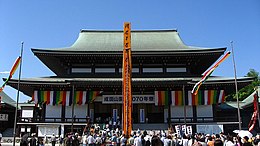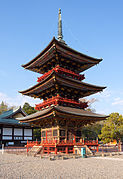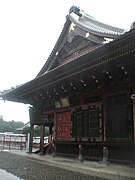Narita-san
Narita-san ( Japanese 成 田 山 , actually: Shinshō-ji 新 勝 寺 ) is a temple of the Shingon school of Buddhism in the city of Narita ( Chiba Prefecture ), which is dedicated to Fudō Myōō .
history
The temple was founded in connection with the revolt of the Taira no Masakado ( 平 将 門 ) in 940. Masakado, who was denied an office at the imperial court, withdrew to the Kantō area and now contested the office of the incumbent Emperor Suzaku . Priest Kanjo, asked for support by the emperor, moved with the statue of Fudō Myoō for three weeks through the Kantō area and performed fire rituals. On the last day of this ritual, Masakado fell in battle, ending the revolt.
When Kanjo wanted to return to Kyōto , the statue of Fudō Myōō became so big and heavy that he could no longer move it. Thereupon a temple with the name Shinshō-ji was built at the behest of the emperor on the spot, namely in Narita, which means "temple of the newly won victory". The temple is the most important of the Fudō Myōō and is visited by more than 13 million believers every year. Especially on the first three days of the new year there is a large number of visitors.
The attachment
(◎ = important cultural asset of Japan )
- - One enters the temple through the Outer Gate ( 総 門 , sōmon ), then the ◎ Niō Gate ( 仁王 門 ) from 1831, in which the two Niō are set up as protectors of the entrance
- - This is followed by the Great Main Hall ( 大本 堂 , hondō ) from 1968 with a length (with the two side pavilions) of 95.4 m, a width of 59.9 m and a height of 32.6 m. The hall is designed in a slightly modernized classic style. Here is the Fudō Myōō, which, according to tradition, was carved by priest Kūkai himself. The Goma ritual ( 護 摩 , goma ), which is typical for the Shingon school, is performed five times a day and visitors can also take part.
- ◎ The three-story pagoda ( 三重 塔 , sanjū no tō ) from 1803 was repaired in 1983.
- - Sutras memory ( 一切 経 堂 , issai kyōdō ) from 1809.
- - Bell tower ( 鐘楼 , shōro ) from 1701 is rung every morning, noon and evening.
- ◎ Buddha's temple ( 釈 迦 堂 , Shakadō ) from 1858.
- ◎ Hall ( 額 堂 , gakudō ) for votive tablets ( 絵 馬 , ema ) from 1861.
- ◎ ( 光明 堂 , kōmyōdō ) from 1701 was the old main hall. Today there is a Dainichi Buddha ( 大 日 如 来 , Dainichi Nyorai ) in it, who is the central cult figure in Shingon.
- - The Great Pagoda ( 大 塔 , daitō ) in the treasure pagoda style was built in 1983 on the hill, a little off the beaten track, to celebrate the 1150th anniversary of Kūkai's death in 1984. With a height of 58 m and a width of 35 m, it is the largest pagoda of its kind in Japan.
- - Shōtoku Taishi Hall ( 聖 徳 太子 堂 , Shōtoku-Taishi-dō ), an octagonal pavilion from 2009, is the latest addition.
- - The temple also has a spacious, wooded park with waterfalls, ponds, lawns and flower beds.
photos
Remarks
- ↑ The priest takes prayer sticks from the visitors, Gomagi ( 護 摩 木 ), which are burned in a cleansing fire ( 焚 ).
literature
- Folder of the temple.








